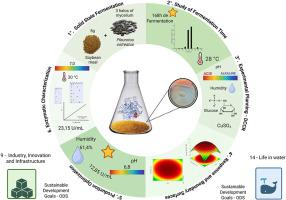Sustainable use of soybean meal in laccase production by Pleurotus ostreatus: Optimization of production and characterization of the enzyme
IF 3.4
4区 化学
Q2 CHEMISTRY, MULTIDISCIPLINARY
引用次数: 0
Abstract
Laccases are oxidoreductive enzymes found in animals, plants, and fungi. Due to their ability to catalyze the oxidation of different phenols and aromatic amines. These enzymes have been widely applied in several sectors, including pollutant degradation, cosmetics, food, and bioenergy industries, especially laccases of fungal origin. In this context, solid-state fermentation (SSF) emerges as a sustainable, economical, efficient, and environmentally friendly alternative for producing this enzyme, utilizing agro-industrial waste. This study aimed to produce, optimize, and characterize laccase by Pleurotus ostreatus cultivated in SSF using soybean meal. Enzyme production was monitored over 240 h to determine the optimal time, followed by a Central Composite Rotational Design (CCRD) to evaluate the parameters of moisture, pH, glucose, and copper sulfate. The characterization of the enzyme included optimal pH and temperature, determination of kinetic constants (Km and Vmax), molecular weight, and zymography. In optimizing enzyme production, pH and humidity were significant factors; the optimal condition was at pH 6.8 and 61.4 % humidity, resulting in an enzymatic activity of 12.85 U/mL and a recovery rate of 82.16 %. In the characterization, the laccase showed maximum activity at neutral pH and 30 °C (23.15 U/mL), with an estimated molecular weight of 65.0 kDa. The results indicate that the enzyme produced is viable for application in industrial and biotechnological processes. Furthermore, soybean meal proved to be a viable, sustainable, and cost-effective alternative for producing laccase by P. ostreatus.

豆粕在平菇漆酶生产中的可持续利用:优化生产和酶的表征
漆酶是一种氧化酶,存在于动物、植物和真菌中。由于它们有能力催化不同酚类和芳香胺的氧化。这些酶已广泛应用于污染物降解、化妆品、食品和生物能源等行业,尤其是真菌源漆酶。在这种情况下,固态发酵(SSF)作为一种可持续、经济、高效和环保的替代方法,利用农业工业废物生产这种酶。本研究旨在利用豆粕在SSF中培养平菇,以其为原料制备漆酶,并对其进行优化和表征。在240 h内监测酶产量以确定最佳时间,然后采用中心复合旋转设计(CCRD)来评估水分、pH、葡萄糖和硫酸铜的参数。酶的表征包括最佳pH和温度、动力学常数(Km和Vmax)的测定、分子量和酶谱分析。pH和湿度是优化酶产量的重要因素;最佳条件为pH 6.8、湿度61.4%,酶活为12.85 U/mL,回收率为82.16%。在表征中,漆酶在中性pH和30°C下(23.15 U/mL)表现出最大活性,估计分子量为65.0 kDa。结果表明,该酶可用于工业和生物技术生产。此外,豆粕被证明是一种可行的、可持续的、经济的替代方法来生产漆酶。
本文章由计算机程序翻译,如有差异,请以英文原文为准。
求助全文
约1分钟内获得全文
求助全文
来源期刊
CiteScore
3.50
自引率
7.70%
发文量
492
审稿时长
3-8 weeks
期刊介绍:
The Journal of the Indian Chemical Society publishes original, fundamental, theorical, experimental research work of highest quality in all areas of chemistry, biochemistry, medicinal chemistry, electrochemistry, agrochemistry, chemical engineering and technology, food chemistry, environmental chemistry, etc.

 求助内容:
求助内容: 应助结果提醒方式:
应助结果提醒方式:


